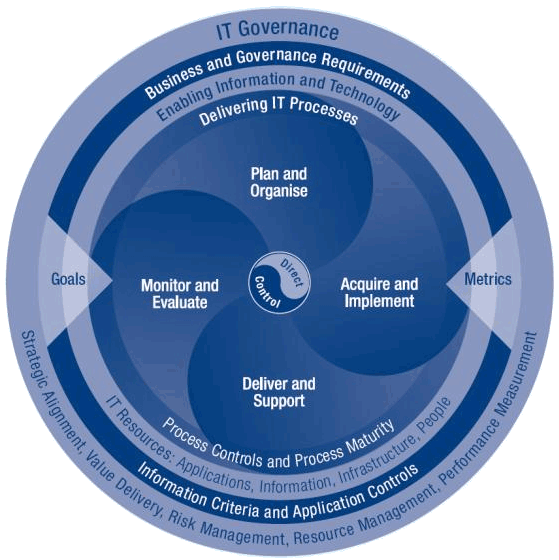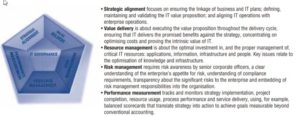
The Information Technology functional alignment with the business goals, objectives and strategies, as well as IT strategic planning, fall under the umbrella of enterprise IT governance, which in turn falls under the umbrella of enterprise governance. It is the responsibility of executives and the board of directors, and consists of the leadership, organizational structures and processes that ensure that the enterprise’s IT sustains and extends the organization’s strategies and objectives. It facilitates the IT function maturing from a common utility model to a partnership model where IT upper management and IT processes are well integrated into the strategic enterprise processes.
IT governance integrates and institutionalizes good practices to ensure that the enterprise’s IT function supports the business objectives. Sound IT governance enables the enterprise to take full advantage of its information, thereby maximizing benefits, capitalizing on opportunities and gaining competitive advantage. These outcomes require a framework for process control over the IT function that maximizes the level of alignment to the business objectives and strategies.
The fiascos of Enron, Worldcom and others gave birth to the Sarbanes Oxley Act and the Committee of Sponsoring Organizations of the Treadway Commission’s (COSO’s) Internal Control— an integrated framework widely accepted as a control framework for enterprise governance and risk management.
Although there are several good frameworks for IT strategic alignment and strategic planning, like the Baldridge Excellence Framework, for example, CIO Services Group has selected the Control Objectives for Information and related Technology (COBIT®) as its framework of choice for managing the IT function as an enterprise aligned resource; an enabler and partner for value creation.

COBIT provides solid practices and presents activities in a manageable and logical structure. COBIT’s good practices represent the consensus of experts. These practices help optimize IT-enabled investments, ensure service delivery and provide a measure against which to judge when things do go wrong.
 For IT to be successful in delivering against business requirements, management should put an internal control system or framework
For IT to be successful in delivering against business requirements, management should put an internal control system or framework
in place. The COBIT control framework contributes to these needs by:
• Making a link to the business requirements
• Organising IT activities into a generally accepted process model
• Identifying the major IT resources to be leveraged
• Defining the management control objectives to be considered
CIO Services Group experts have implemented COBIT and other IT governance, alignment and strategic planning frameworks successfully in other companies. We can definitely help you achieve this goal. Your company cannot afford not to. Don’t hesitate to contact us. We’ll jointly explore how you can get to that position.